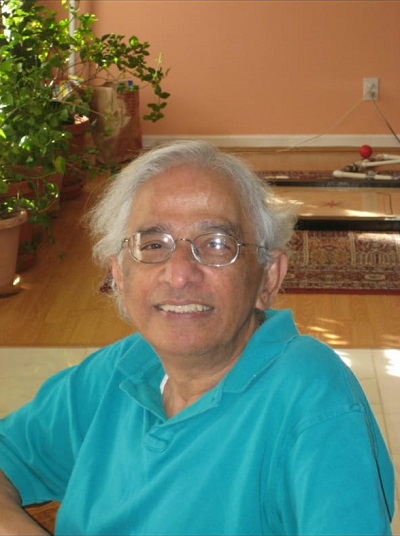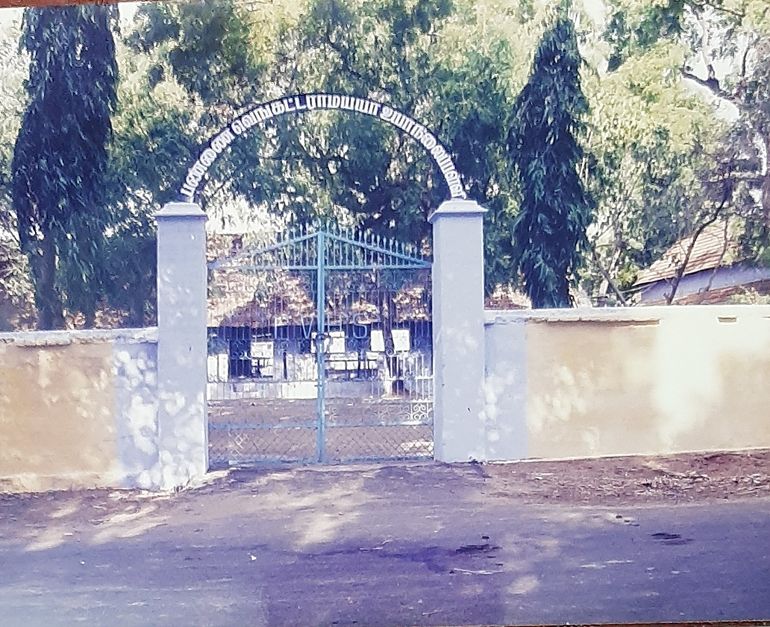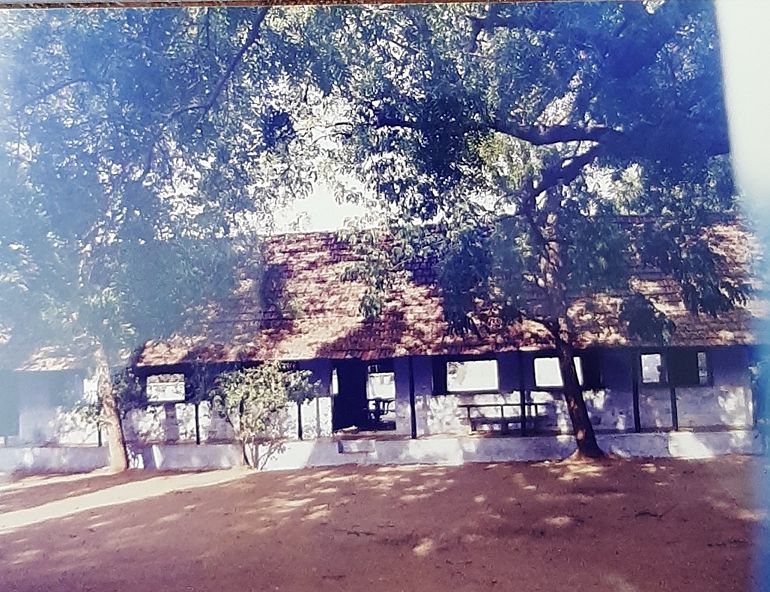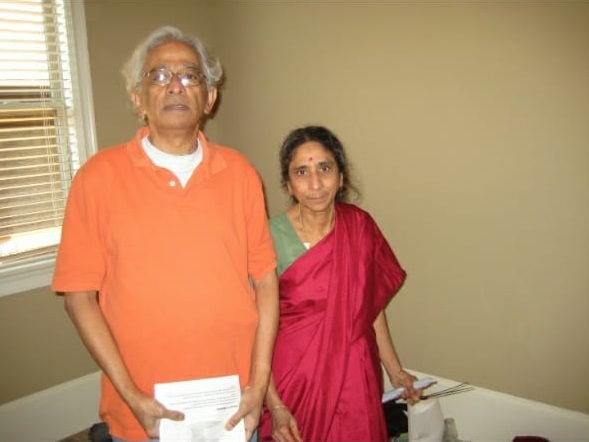Ramamoorthi, as I knew him – Recollection from Board Chair Dr. Ragu S. Raghupathy
As a young boy, my summer school vacations were always spent with my grandparents in Gopalasamudram and my grandfather in Palamadai. My earliest recollection of interaction with Ramoorthi, that is the way he was known and called, was during one of these visits. The difference in ages between us was not that wide apart to address him in the respectable vernacular.
Ramoorthi, born in Rangoon (Yangon) in June 1937, moved with his parents to India in 1941, when the Japanese were knocking at the doors of Burma (Myanmar), in one of the last ships leaving Burma (Myanmar). Except for the two elder brothers who stayed behind in Rangoon (Yangon), the rest of the family moved to Gopalasamudram, a village on the southern bank of the Tamirabharani river, 8 km upriver from Tirunelveli. However, in those days, the distance by the street was 17 km as there was only one bridge over the river. (A new bridge across the river just to the east of Gopalasamudram has reduced this distance to 12 km).
The travel from the Tirunelveli junction to Gopalasamudram was in a bullock cart, which my grandfather organized. That trip would take more than an hour. However, the well-to-do people would use a “pleasure,” a word used to describe all those big comfortable US cars, to the village. Once a “pleasure” drives into the village, all the children would run towards it to enjoy its sight. Then someone had come from “பட்டணம்” would be known by every household in the village.

The village “அக்கிரஹாரம்” consisted of (using past tense here as things might have changed over the years) of a street running east-west with a cross street running towards the “வாய்க்கால்” and over a small mound to the Tamirabharani river. This cross street divided the village into two halves, a smaller western half, and larger eastern half. At the western end of the village, there was a Vishnu temple facing directly east and formed a dead end. A Shiva temple was on the eastern side of the village and was on the northern side of the street. The cross street seemed to divide the Vaishnavite and Shaivite population. All the homes in the were traditional homes of yesteryears, with a “திண்ணை,” a verandah.
There were two schools, Mahadevayyar Elementary School, next to the Shiva temple on the east, and Pannai Venktramaier High School at the west end of the street, just to the northwest of the Vishnu temple with rice fields on the other side. Rammorthi studied in those schools from the fourth class. Since it was the only High School within a 3 km radius, other village children also came to this school. Rammorthi remembered fondly his days at the High School, and later in his life supported this school with financial assistance.
Ramoorthi lived for the first few years in Gopalasamudram in a small home facing south on the back of which was the “வாய்க்கால்.” This home had a characteristic hand pump in the courtyard. (I was born in this house). After five or six years, the family moved to a house just across the street.


In the village, all the children happily played with their creative toys. One such toy was “வட்டில் வடம்.” This ingeniously made unit was a combination of an iron rod beautifully bent to a perfect circle with local techniques, and a pusher made from the end of a palm leaf branch. The mud street with its undulations offered challenges to navigate the contrivance. The children made merry especially on full moon days when the whole street was fully lit with the moonlight.
In Gopalasamudram, as a city boy, I did not know how to swim, eat overnight soaked rice (பழையது) with buttermilk in the morning – now touted by nutritionists as one of the best breakfasts. I learned to play with the “வட்டில் வடம்”. Ramoorthi made by such a unit so that I could compete with other boys who were also in their summer sojourn in the village. I could never master playing with it though. Ramoorthi’s s attempt to teach me swimming failed, although I joined the trek towards the river every morning. There was a huge rock near the middle of the river, where the water depth was the highest. The locals always had their bath there. Kitcha Mama, I believe, was the best among all of them in swimming.
Ramoorthi along with Kitcha Mama and Ramanathan (Rana)(Ramoorthi’s cousin) entertained me with everything the village had to offer. They made an eatable, better to call a delicacy, called “சொக்கட்டான் புளி,” a concoction of tamarind, green chilies, jaggery, and salt. This was made when no one was looking around, especially my grandfather. It had to be eaten ( tasted) without anyone noticing it. Heavenly indeed!
All of us had aluminum eating plates, which we should clean and wash and hang them on the wall. That habit is still with me. In those days, Gopalasamudram was one of the first villages to get electricity. There were streetlamps, and all of us played right into the night. Two or three homes in the village could afford radios those days. I did not know much about Cricket then. We were all standing outside the homes with radios listening to the cricket commentary. Since it was summertime, these matches were played in England, and with the feeble reception on shortwave transmissions from the BBC, the scores were passed from inside the house to those standing outside.
Ramoorthi was the funniest of all my uncles, and he cracked jokes all the time. Rana and Ramoorthi were remarkably close and did a number of things together. People, that includes many family members, used to make fun of Ramoorthi’s s eyesight and he took it sportingly. But he never forgot about it.
The family moved to Madras (Chennai) in 1955 after Ramoorthi’s schooling and his Intermediate in Xavier’s College in Palayamkottai. He joined Vivekananda College for his Chemistry degree. Thanks to Mani Mama, the family could move into a beautiful house on 16 West Circular Road. Ramoorthi was a day scholar. The family lived frugally and the matriarch, my Patti, held the family together. In those days, money was hard to come by. After the first year or so, a Raleigh bicycle was purchased for Ramoorthi for his commute to the college. It was his prized possession. The family also switched from tooth powder (Nanjangodu) to toothpaste. Binaca toothpaste was quite popular those days. The major reason for its popularity was the Binaca Geet Mala, which counted down the most popular songs of that week. Binaca toothpaste box had a sticker in it, which could be affixed on items. The very first purchase of the toothpaste had a sticker of an American Indian – with flowing hair and red face. All of us joined in affixing it to the front mudguard of the bicycle. That cycle has changed hands – from Ramoorthi to me, then to my cousin Raman, and then to Ganesan who worked with my father. Unbelievably, the cycle is still there, and you can see the traces of the sticker. A service of 65 + years and counting!

Once we went to see a late show of the movie “காலம் மாறிப் போச்சு” (1956) at the Wellington Cinema. Ramoorthi went to the theater in his cycle with a cycle light powered by kerosene. If the police caught you without a light, you had to pay a fine or a bribe (the latter was always the preferred option). Kitcha Mama and I went by bus. Ramoorthi was ahead in the queue (the ticket price was fifteen annas ). Kitcha and I were back in the line. When Kitcha and I reached the counter, there was only one ticket left. Kitcha insisted that I see the movie and he went home. At the end of the movie, I rode pillion in Ramoorthi’s cycle. Riding as a pillion was not allowed then. We had to pass the Royapettah Police station. I had to get down and walk a stretch before could ride again. When we reached home, my mother was not amused that I decided to see the movie without Kitcha.
During these years, we always got together for card (Trump) games and Ramoorthi cheated sometimes. The other popular game was the Carrom board. A little cricket outside the house was also common. It was total fun.
Ramoorthi got a job in the Indian Atomic Research Center in Mumbai (Bombay (Mumbai)) after his B.Sc. degree. He used to come to Madras (Chennai) for holidays. I remember canceling my school excursion because Ramoorthi was going to be in Madras (Chennai). He always took me to movies whenever he came to Madras (Chennai). On a rainy day, we managed to see “சபாஷ் மீனா,” a full-length comedy at Casino with a friend of Ramoorthi. We had delectable snacks in the store close to the New Elphinstone cinema after the movie.
During one of his visits, he brought a radio that he had built from scratch. That radio had valves, and the chassis would get extremely hot if you played the radio for a long time. That was the first-ever radio that the family had. Listening to the commentary standing outside on the street in Gopalasamudram was the impetus for him to build a radio for his parents, he later told me. What a delight it was for the family! There was one constant problem with this radio. The contrivance of pullies and thread which tuned the capacitors to the required wavelength was not a robust design. The dial did not move properly after repeated usage. I used to fix it whenever it happened.
After my SSLC exams were over in 1960, I had the opportunity to go to Bombay (Mumbai) as our family friends were returning to Bombay (Mumbai) from Madras (Chennai). They were traveling in first class, and I was traveling in third class. That was the first time I traveled alone in India. At Poona (Pune), I moved to their compartment, illegally of course, to make sure that I did not get stranded in Dadar – that is where Ramoorthi was going to pick me up. The train reached Dadar, and Ramoorthi was not there. So, I went with that family to their beautiful flat on Marine Drive.
Since they had a phone at home( a rarity in those days), they tried to reach Ramoorthi’s s office. After a day, it clicked and Ramoorthi came over to pick me up. I believe the letter written about my travel had not reached him. I went with him to a room he shared with his friends in Sion. Since he was working, I moved to Thane, where my Chitti lived. I had a season ticket for travel between Sion and Thane and I made use of it. Ramoorthi was studying in the evenings for his master’s program at the University of Bombay (Mumbai). Hence, only on some weekends, we could spend time together. He took me to all the important places in Bombay (Mumbai).
There was a music show at that time called “The Shankar-Jaikishan Nite” at the Worli Stadium. Since I was a great fan of the Music duo, Ramoorthi got me a ticket. He came along with me to show me the bus and train to take to return home after the concert. Seeing the crowd, Ramoorthi decided that he cannot leave me alone. So, he squeezed pass the ticket collector without a ticket. Both of us enjoyed the program immensely.
It was time for me to return alone to Madras (Chennai). We got on the train at Sion. My pocket was picked and with that, I lost my train ticket. We quickly got out in the next station, and Ramoorthi and I reached the Victoria Terminus, and he bought another ticket as the stationmaster would not trust us. Another unnecessary expense indeed.
A week before my pre-University Exams in 1961, Ramamoorthi had come to Madras (Chennai) on holiday. Despite the upcoming exams, both Ramoorthi and I saw “Jis Desh Mein Ganga Behthi Hai” at Midland. There was opposition as it was just a few days before the English exam. He used to hum songs from the movie continuously.
I joined Engineering, and Ramoorthi’s s trip to Madras (Chennai) was also reduced. He told us that he had an Assistantship from McGill University, Canada, and will be leaving that September (1964). A few things regarding his first trip bothered him forever. He was looking for assistance in the form of a loan from some family members for travel, but he was unsuccessful. So, he had to take the cheapest way to reach Canada by boat. He reached Europe by boat and flew the leg from Europe to Montreal. He came home to say goodbye to Thatha, and Patti and I missed him when he came home. When I reached home from college, my mother told me that Ramoorthi just left for the Mandavelli Bus Stop. I rode in my cycle, now mine given by Ramoorthi, and caught up with him at the Mandavelli Bus stand. The next time I will see him will be at the Frankfurt Airport.
We hardly heard from him. Patti used to get letters from him now and then. We heard indirectly that he was involved in a car accident. Although nothing happened to him, we heard through grapevine that he had to pay damages. That must have strained him financially.
I left India for Germany in 1970 for doing my doctorate in Germany. I was not well versed in the financial constraints of people doing their Ph.D. in the US or Canada. From the perspective of people in India, I thought they would have money to spare without any reservation. Now I know better. The people with whom I was in Germany told me that winter coats were better and cheaper in Canada. So, I wrote to Ramoorthi to send me one. He responded immediately stating that it will be difficult for him to do it. But he sent me $ 20 (coming to think of it, a considerable amount of money then). If I can reverse one thing in my life, this would be the event. I was ignorant to have asked this favor.
A couple of years later in 1973, I received a letter from him that he was getting married to Susila Mami and will be going through Frankfurt. He wanted me to buy some perfume since he did not know much about them. I bought the perfume to give him at the Frankfurt airport. I reached the airport on time and was waiting for Ramoorthi to show up. In those days, it was not difficult for people to come out of the immigration to meet others outside. He came out and he looked different to me since I last saw him at the Mandavelli bus stand. I gave a box containing the Chanel perfume. Felt better that I compensated for the gift of $ 20 that he had sent me.
It turns out that I had seen Susila Mami at the Indian Institute of Science where she was doing her Ph.D. in Physics and where I did my Masters’s. Several of Susila Mami and her friends used to watch our cricket matches. My mother reminded me on one of my trips about Susila Mami. She was the daughter of one of my mother’s friends. My mother and Susila Mami’s mother went to the Kapali temple together. I had spoken with Susila Mami’s mother more than Susila Mami until I met her in the US. They used to live in Lazarus Church Street which was a mere five-minute walk from where we lived.
I had an opportunity to come to the US in July 1978. So, we left India on July 4th, 1978. Since Ramoorthi was living far away at Shoreham, we went to stay with Lalitha’s uncle in Beacon, NY. When I called Ramoorthi, He was surprised that we were in NY and came over with Mami to see us. We had a wonderful time. We used to call each other at least a couple of times a month during our stay.
We left the US to try our luck in India in June 1981 and left with Ramoorthi our savings. These savings would come in handy when we returned in June 1982. We lived in Columbus, Ohio. The money I had saved was not enough to start the proceeding in Columbus. I had taken a loan from him to establish us again in Columbus, which I repaid within a couple of years.
Ramoorthi had a heart attack in 1984. I did not know it until he returned home after the surgery. I rushed to Shoreham, NY. He explained to me what happened. As his stretcher was taken into the operating theater, he told me he was reciting the Gayathri Mantra. He had to change his food habits. Ramoorthi always liked, what we call “நொறுக்கு தீனி” (snacks do not just cut it for the Tamil word), “தட்டை, முறுக்கு” etc. He had to let go of this, unfortunately after the surgery. I installed a room air conditioner for his bedroom.
Ramoorthi and Susila Mami visited us wherever we lived in the US – Dublin, Charleston, and Farmington Hills. He was always in a hurry. Did not want to take it easy at all. Our conversations were always about our younger days and especially about Gopalasamudram. In one of his trips to Charleston, SC in 1992, I had taken him to Kiawah Island. I noticed during this trip that he would want me to stop at any phone booths on the way and kept calling someone. It was to his stockbroker. After one call in Kiawah Island, he came to me beaming and asked “ Raghu, do you know any millionaire?” I said “No.” Then, he said. “ Now you know one”!
He also narrated anecdotes during our conversation. A couple of them here: Once, he went for the doctor’s appointment on time, and the doctor did not see him for more than 30 minutes. Soon thereafter he received a bill from the doctor. Ramoorthi sent the doctor his own invoice for the charges of having made him wait. I am not sure how it ended. Another incident involved the visit of the former Indian President Zakir Hussain to McGill University. When Ramoorthi approached him for a conversation, Zakir Hussain started speaking in Hindi. Ramoorthi responded in Tamil. Ramoorthi always spoke up, and that was a good thing.

We have had heated discussions on various subjects but all of them ended in hearty laughter. When he attended our son’s marriage in Atlanta in 2009, he was planning to move to be close to Susila Mami’s sister. He always suggested that both of us should relocate to a place together after retirement. Due to constraints, we could not do it. Shankar had offered for Ramoorthi to come and stay with him in the Silicon Valley. But he did not want to do it either.
He liked Neelu Mama very much. He could not stop saying how Neelu Mama took care of Patti. He always stayed with him when he visited Madras (Chennai). During one of his last outings in 2013, we decided to go village hopping in Tirunelveli. We flew into Madurai and drove down to Tirunelveli. Susila Mami stayed in the hotel. Ramoorthi and I traced the paths of our ancestors’ visiting villages along the southern bank of Tamirabharani. He became very emotional in Gopalasamudram and was slightly disappointed that the classrooms in the High school, which he had funded did not progress well at all. He wanted to do more for his school. That trip was one of his dream trips.
He always wanted to give all his savings away. I may have told him many times to do it when he was alive so that he could see the benefits to others, especially educating disadvantaged children. That was close to his heart. I had advised him to adopt a child and he never wanted to do it. He was becoming computer literate and I have spent time on and off helping him set up his system.
Shankar and I visited him in his place in 2015 for a few days. We had an incredibly fun time. We talked about, you have guessed it, Gopalasamudram and other younger day events. One could sense that he still was bitter about a few things that happened to him in India. He was also delighted that a new medication had been introduced which would neutralize the waning effects of his heart surgery. He was able to have this treatment. We had frequent phone calls. He was thrilled suddenly about attending the “Sudarshan Kriya” classes. For me, it was a little risky as he was a heart patient. When I took this course, I distinctly remember my teacher asking everyone in the class whether we had any heart-related issues. She was not keen for them to participate.
The jury is still out whether the turn for the worst in his condition was the result of this exercise. That is too delicate a topic to further speculate here. One day in late November 2017, I got a call from Susila Mami about the deteriorating condition of Ramoorthi. I rushed to Atlanta. I was shocked to see him. His face had dark patches and he was confined to a bed. He was happy to see me. He was proud that he could make tea still. I asked him whether I can take a picture of him and share it with others – thinking back I am not sure that was a great idea. I did take his picture and sent his picture to others. Others were shocked to see it as well.
Another mistake I may have committed was to share about his health from my perspective with others. Ramoorthi had access to these posts. He may have made his own decisions from those posts. We had to go and meet his doctor one evening. The doctor was giving a hint. He asked us to give him anything he wanted to eat, and nothing should be out of bounds. But Susila Mami was not for it. We went to an Indian Restaurant that evening, and Ramoorthi enjoyed his Vada/Sambar and the delicious Lassi.
Suddenly, the next day, his condition worsened, and he was admitted to the hospital. I spent the days with him there. Shankar and I were going to take turns to be with him as long as it took for him to fully recover. I was in the hospital on the morning of Dec 3, 2017. I told Ramoorthi that Shankar will be there that afternoon, and I will be back after a week. I fed him his meal – cauliflower with rice before leaving the hospital. Alas, I did not know that would be the last meal that Ramoorthi will have on this earth! I had not even unpacked my stuff back home when I got a call from Shankar that Ramoorthi breathed his last at the Hospice.
I immediately left for Atlanta and joined Shankar to perform the last rites of Ramoorthi. Both Shankar and I were thankful that we were able to perform the last rites of Ramoorthi.
May Ramoorthi’ s memory be a blessing!


